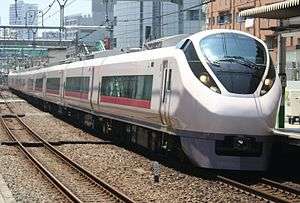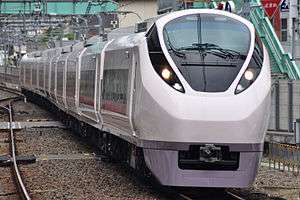Hitachi (Japanese train)
|
E657 series EMU | |
| Overview | |
|---|---|
| Service type | Limited express |
| Locale | Japan |
| First service |
1963 (Hitachi) 1989 (Super Hitachi) 1997 (Fresh Hitachi) |
| Current operator(s) | JR East |
| Former operator(s) | JNR |
| Route | |
| Start | Shinagawa/Ueno |
| Stops | Iwaki |
| Line used | Jōban Line, Tōhoku Main Line |
| On-board services | |
| Class(es) | Green + Standard |
| Catering facilities | Trolley service |
| Technical | |
| Rolling stock | E657 series |
| Track gauge | 1,067 mm (3 ft 6 in) |
| Electrification | 1,500 V DC / 20 kV AC 50 Hz |
| Operating speed | 130 km/h (80 mph) |
Hitachi (ひたち) is a limited express train service operated in Japan by East Japan Railway Company (JR East) on the Jōban Line between Shinagawa Station and Ueno Station in Tokyo and Iwaki in Fukushima Prefecture. The Tokiwa service follows the same route but makes additional stops.
Hitachi
The Hitachi (ひたち) name was first introduced on 1 October 1963 for a semi-express service which operated daily between Ueno and Taira (present-day Iwaki) using 451 series EMU stock, will all cars reserved.[1] This service operated until 30 September 1967.
The name was subsequently reintroduced on 1 October 1969 for a once-daily seasonal limited-express service operating between Ueno and Iwaki using 7-car KiHa 81 series diesel multiple units.[1] This became a regular daily service the following year.[2]
485 series EMUs were phased in from 2 October 1972, and were used until services were discontinued in December 1998. From 1 April 1973, one return service daily was extended to operate between Ueno and Sendai. From 1 October of the same year, the number of services to and from Sendai was increased to six return services. From 2 October 1978, this number was increased to 11 return services daily, to 12 from 15 November 1982, to 23 from 14 March 1985 with the discontinuation of the Tokiwa express, and to 26 return services daily from 1 November 1986.[2]
During the 1990s, services were operated using Katsuta-based seven-car 485 series formations with no Green car accommodation. Fourteen-car formations were sometimes used.[3]
Super Hitachi
The Super Hitachi (スーパーひたち) was introduced on 11 March 1989, operating between Ueno and Iwaki and Sendai, using new 651 series EMUs.[2] It operates at a maximum speed of 130 km/h.[4] Services are generally formed of 7-car or 7+4-car formations, with only the 4-car sets continuing north of Iwaki.[5]
From the start of the revised timetable on 17 March 2012, new E657 series EMUs were phased in on some Super Hitachi services,[6] and entirely replaced the 651 series trains by the start of the revised timetable on 16 March 2013.
Fresh Hitachi
The Fresh Hitachi (フレッシュひたち) was introduced on 1 October 1997 between Ueno and Iwaki, using new E653 series EMUs.[2] It operates at a maximum speed of 130 km/h. Services were initially formed of 7-car, 7+4-car, or 7+7-car E653 EMUs, as well as 7-car or 7+4-car 651 series EMUs.[4]
The Hitachi name itself was discontinued from December 1998 with the withdrawal of the last 485 series electric multiple units (EMUs) on the Jōban Line, with the main daytime limited express services subsequently being named Super Hitachi and Fresh Hitachi.[2]
From the start of the revised timetable on 17 March 2012, new 10-car E657 series EMUs were introduced on Fresh Hitachi services, operating alongside existing 651 series and E653 series sets,[6] and as of 16 March 2013, all services are operated using E657 series EMUs. During the period between 1 October 2013 and around March 2015, however, one up and one down Fresh Hitachi service daily will be operated by an 11-car 651 series formation covering while the E657 series fleet undergoes modification work to add LED seat reservation status indicators above each seat.[7]
Ueno-Tokyo Line extension
From the start of the 14 March 2015 timetable revision, Super Hitachi services were renamed simply Hitachi, and Fresh Hitachi services were renamed Tokiwa. From the same date, services were extended south of Ueno via the new Ueno-Tokyo Line, with most services terminating at Shinagawa Station.[8]
Rolling stock

As of 16 March 2013, all services are operated by E657 series 10-car EMUs, first introduced from March 2012, although 11-car 651 series formations will be substituted on some services between 1 October 2013 and March 2015.[7]
Past rolling stock
- 451 series EMUs (Hitachi, October 1963 - 30 September 1967)
- KiHa 81 series DMUs (Hitachi, October 1963 - ?)
- 485 series EMUs (Hitachi, 2 October 1972 - December 1998)
- 651 series 4/7/11-car EMUs (Super Hitachi, Fresh Hitachi 11 March 1989 - 15 March 2013)
- E653 series 7/11/14-car EMUs (Fresh Hitachi since 1 October 1997 - 15 March 2013)
 JNR 451 series
JNR 451 series "Bonnet-style" 485 series on a Hitachi service, August 1998
"Bonnet-style" 485 series on a Hitachi service, August 1998 651 series on a Super Hitachi service, July 2005
651 series on a Super Hitachi service, July 2005 E653 series on a Fresh Hitachi service, April 2003
E653 series on a Fresh Hitachi service, April 2003
Formations
Trains are formed as shown below, with car 1 at the Ueno end. All cars are no smoking.[9]
Super Hitachi
| Car No. | 1 | 2 | 3 | 4 | 5 | 6 | 7 | 8 | 9 | 10 |
|---|---|---|---|---|---|---|---|---|---|---|
| Accommodation | Reserved | Reserved | Reserved | Reserved | Green | Reserved | Reserved | Non-reserved | Non-reserved | Non-reserved |
Fresh Hitachi
| Car No. | 1 | 2 | 3 | 4 | 5 | 6 | 7 | 8 | 9 | 10 |
|---|---|---|---|---|---|---|---|---|---|---|
| Accommodation | Reserved | Reserved | Reserved | Reserved | Green | Reserved | Non-reserved | Non-reserved | Non-reserved | Non-reserved |
See also
References
- 1 2 Ikeguchi, Eiji (February 2013). "JR東日本651系・E653系 常磐線特急の足跡" [JR East 651/E653 series - History of Joban Line Limited Expresses]. Tetsudō Daiya Jōhō Magazine (in Japanese). Vol. 42 no. 346. Japan: Kōtsū Shimbun. pp. 64–69.
- 1 2 3 4 5 Haraguchi, Takayuki (2009). Encyclopedia of JR's Railway Cars: JR全車輌. Japan: Sekai Bunka. p. 218. ISBN 978-4-418-09905-4.
- ↑ 列車名鑑1995 [Train Name Directory 1995]. Japan: Railway Journal. August 1995.
- 1 2 JR新幹線&特急列車ファイル [JR Shinkansen & Limited Express Train File]. Japan: Kōtsū Shimbun. 2008. ISBN 978-4-330-00608-6.
- ↑ JR Timetable, December 2008 issue
- 1 2 2012年3月ダイヤ改正について [March 2012 Timetable Revision] (pdf) (in Japanese). Japan: East Japan Railway Company. 16 December 2011. Retrieved 16 December 2011.
- 1 2 常磐線特急ひたち号の編成変更について [Changes to Joban Line Hitachi limited express formations] (PDF). News Release (in Japanese). Japan: East Japan Railway Company - Mito Division. 8 August 2013. Retrieved 8 August 2013.
- ↑ 「上野東京ライン」開業により、 南北の大動脈が動き出します [North-south artery comes into operation with opening of Ueno-Tokyo Line] (PDF). News release (in Japanese). Japan: East Japan Railway Company. 30 October 2014. Retrieved 30 October 2014. line feed character in
|script-title=at position 19 (help) - ↑ JR Timetable, March 2013 issue, P.996
External links
| Wikimedia Commons has media related to Hitachi (Japanese train). |

.svg.png)